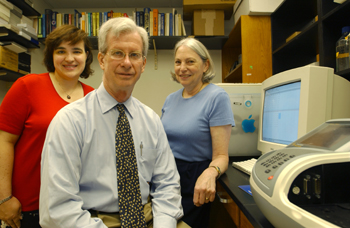
Left to right: Amy Motley, Raymond Burk, M.D., and Kristina Hill, Ph.D., are investigating the nutritional effects of selenium. The team recently received a MERIT award from the NIH. /Photo by Anne Rayner
Raymond Burk’s research garners MERIT award
Raymond F. Burk, M.D., professor of Medicine and Pathology, has received a coveted MERIT (Method to Extend Research in Time) award from the National Institutes of Health for his research on the nutritional effects of selenium.
MERIT awards recognize and reward consistently high grant performance by providing up to 10 years of continuous funding without competitive review.
“The award will allow us to focus on the science instead of having to play the grant game,” Burk said. “I’m very happy to get a MERIT award; it’s an honor.”
“Clearly this is one of the highest honors that a researcher can receive, and we’re so proud of Dr. Burk,” said Steven G. Gabbe, M.D., dean of the School of Medicine.
“This new MERIT award is not only a well-deserved recognition of Dr. Burk’s significant research contributions, but it is yet another sign of the thriving research enterprise here at Vanderbilt,” added Jeffrey R. Balser, M.D., Ph.D., associate vice chancellor for Research.
Burk’s interest in selenium, an essential trace element, dates to his days as a first-year Vanderbilt medical student 40 years ago. “That was really before much was known about the biological role of selenium,” Burk recalled, “and I’ve just continued to work on it ever since.”
Burk and others have discovered that selenium’s nutritional effects depend on “selenoproteins” — proteins that incorporate selenium into their structures. There are approximately 25 different kinds of selenoproteins in the human body, and most of these are enzymes that serve vital functions, Burk said. The enzymes that metabolize thyroid hormones are selenoproteins, as are the thioredoxin reductases, which participate in protecting the cell from oxidative stress.
Burk and colleagues including co-investigator Kristina E. Hill, Ph.D., research associate professor of Medicine, have focused for some time on selenoprotein-P, a circulating selenium transport protein. Burk’s team was the first to recognize selenoprotein-P, to purify and characterize it, and to clone and sequence it. Brain, testis, and placenta have specialized mechanisms for extracting selenium from selenoprotein-P, Burk said. “We are in the process of elucidating this very efficient uptake process.”
Selenoprotein-P knockout mice have proven useful in verifying the critical need for dietary selenium and in studying the transport protein’s roles. Mice without selenoprotein-P die unless they consume large quantities — 10 times the normal amount — of selenium.
When the knockout mice eat food with normal levels of selenium, they develop neurological problems including uncoordinated movements and neuronal cell death and ultimately die. Even with high selenium intake, the male knockout mice are infertile.
“We’re now trying to characterize the effects of selenium deficiency in the brain, and whether the damage we see in mice is related to any human diseases,” Burk said. “You can imagine that a person with a mutation in selenoprotein-P or in the mechanism for taking it up into the brain might have some neurological damage or be predisposed to having neurological damage.”
Likewise with respect to male infertility, the investigators will characterize the effects of selenium on spermatogenesis, he said.
“If we identify this problem in human male infertility or in neurological disease, something as simple as a selenium supplement might solve the infertility problem or prevent the disease. We just don’t know,” Burk said.
“This is a classic example of how basic research might have an impact in the clinical arena.”
In other studies, Burk and collaborators have worked to develop biomarkers of selenium. These biomarkers are expected to be useful in clinical studies of selenium supplementation, such as those ongoing for cancer prevention.
The investigators are also completing a project that aims to determine the recommended dietary allowance of selenium.













